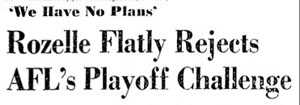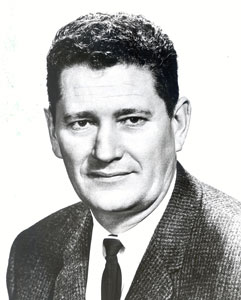|
A younger sports writer can only imagine what it must have been like
to cover the American Football League in 1960. It seems like such a
distant time now. John F. Kennedy had not been elected when the
first game was played. The space program was in its infancy. The
tumult of the Sixties was still a faraway murmur.
It must have been incredibly exciting to be Larry Felser back then,
to be a young reporter getting his first crack at pro football, to
feel a writing career and a new football league ascending together,
uncertain where it would all lead.
Felser hopped aboard the AFL that first year, and he got the ride of
his life. This week, he rides into retirement, leaving daily
newspaper work exactly 50 years after taking his first job as a copy
boy at the Courier-Express.
Pro football took him from creaky old ballparks to shiny domed
stadiums; from portable typewriters to Windows 98; from Cookie
Gilchrist to O.J. Simpson to Thurman Thomas; from the old Courier to
the Pro Football Hall of Fame.
He saw the AFL grow, in the space of 10 years, from a maverick
upstart league to a respected competitor and, finally, a partner
when it merged with the NFL in 1970. He chronicled the league as it
evolved into America’s pre-eminent sporting institution. He has
covered all 35 Super Bowls and saw his hometown team play in it four
consecutive times.
By the end of the 1960s, Felser was a national figure in the sports
media; he was a respected weekly voice in The Sporting News for a
quarter century. But through it all, he remained at heart a Buffalo
guy, a local treasure, an all-around good person who never changed
and never lost sight of his roots.
“He’s one guy you don’t have to lie about,” said Jerry Izenberg, the
veteran sports columnist at The Newark Star-Ledger. “Larry Felser
comes from a class of columnists who wrote for the people. They
didn’t write lines, they wrote for the people. It’s a dying thing.
There was no question who Larry’s audience was. From what I know of
him and about Buffalo, I think it was the perfect marriage.”
Izenberg and Felser are among the eight sports writers who have
covered every Super Bowl. It’s a distinction they cherish. Every
year, the eight look forward to meeting for dinner during the week
of the big game.
“It’s like a drug,” Izenberg said. “If we’re not there, that means
we’re dead. Generally, we hold each other up.”
Izenberg said he and Felser shared a special affinity because Newark
and Buffalo were similar cities, unfairly maligned in the national
consciousness. He said Felser rose above any negative perceptions of
his hometown. Vic Carucci, who worked alongside him for nearly 20
years on The News’ football beat, said Felser felt it was his duty
to represent Buffalo well.
“He carried the Buffalo pride thing more than any of us,” Carucci
said. “You weren’t just a representative of The Buffalo News, you
were from Buffalo. No matter where you went, whether it was New
York, Chicago or LA, they showed a remarkable respect for this man,
and by extension, for Buffalo. He understood that how you carry
yourself went a long way, and it was a valuable lesson. It was never
anything he spoke of. You had to observe it to learn it.”
That level of respect doesn’t come by accident. Felser achieved it
through decades of dedication and hard work, through countless hours
spent cultivating sources and earning the trust of coaches, players,
executives and other writers. They say the most important thing a
man has is his word. In Felser’s case, his word – or his words –
were impeccable.
“When people read Larry Felser, they said, ‘This is accurate. This
is true,’ ” said Will McDonough, the longtime Boston Globe football
writer and TV analyst, and one of the eight to cover all the Super
Bowls. “Everybody respects him. He’s been fair, honest, accurate –
everything you’d want if you owned a newspaper. Married to the same
gal, all the traditional values. And he’s never changed.”
Former News columnist Jim Kelley, who worked with Felser for more
than 30 years, said Felser is more appreciated outside Buffalo than
anyone could imagine. “And that’s saying a lot,” Kelley said,
“because he’s really appreciated here. Everywhere I’ve ever gone, if
I told someone, ‘Larry Felser said hello,’ the door swings open. The
guy opened more doors for me than any doorman at the Marriott. And
no one ever said, ‘You’re friends with that jerk?’ Never.”
He was always ready with a kind word, or a helpful piece of advice,
for a fellow writer. Carucci said one of the highlights of his early
career came when former Bills coach Chuck Knox called him with a
scoop, because Felser had told him Carucci could be trusted. The
highest compliment you could get was when Larry called you “Cuz,”
which meant you were OK in his book.
Felser was a tough guy to compete with. Jim Peters, who took over
the Bills’ beat for the Courier when Felser came to The News in
1963, said he worked hard to build up contacts, but he could never
keep up. But he was grateful, because going against Felser kept you
on your toes. It made you better. And you could always count on him
as a friend.
“I remember the day the Courier-Express closed in 1982,” said
Peters, who is now retired from The News. “I wasn’t in the office 10
minutes when the phone rang. It was Larry. He said, don’t do
anything foolish. We’d like you to come down here. It was one of the
most welcome phone calls I ever had. I’ll never forget him for
that.”
The guy wasn’t perfect. Like many sports writers, he had his share
of adventures with cars. Carucci says he’ll never forget the time
Felser drove a rental car out of the Orange Bowl parking lot after
covering a Bills-Dolphins game and took a wrong turn. Carucci and
Milt Northrop looked on in horror, certain they were about to die,
as Felser narrowly missed colliding with a car going 80 mph.
“He’d been at the Orange Bowl more than the rest of us put
together,” Northrop said. “And every time he left that place, he
still turned the wrong way.”
Carucci said from that point forward, he was the designated driver
on road trips. Felser did not object.
Edwin Pope, the veteran Miami Herald sports columnist (and yes,
another of the original eight), recalled that he and Felser covered
the United States’ historic win over the Soviets in hockey at the
1980 Olympics in Lake Placid. When they came out of the arena,
Felser’s rental car was gone. It had been towed. Felser paid about
$150 to reclaim it at the police station, only to find that the
front end had been ruined. Miracle on Ice indeed.
Pope said it was the only time he ever saw Felser really angry.
Mostly, he just rolled with the punches.
Affable and accurate, that’s Larry. A gifted writer and dogged
reporter who gave you the clear, unvarnished truth.
“I used to call him the Swami,” said Ed Abramoski, who was the
Bills’ trainer for the first 36 years of their existence and is now
on the Wall of Fame. “Larry was always so up on what was going to
happen in the NFL, he’d tell me ahead of time. I’d say, ‘Go on. What
are you, a swami?’
“The players might not have liked what he wrote. But one thing they
always told me was Larry always had the facts. You might not agree
with the premise or the conclusion, but his facts were always
correct. As a matter of fact, when Billy Shaw asked me to give his
introduction at the Hall of Fame, I called up Larry, and we went to
lunch.”
Abramoski said Felser was instrumental in Shaw becoming the first
Hall of Famer to play his entire career in the old AFL, although
Felser wouldn’t take the credit. But he could be a persuasive voice
when those votes were being taken.
“When he gets up and talks in those meetings, everybody listens,”
Pope said.
“They don’t make them like him anymore,” said Knox, who met Felser
as a Jets assistant in 1963. “I really believe that. He’s one of a
few that came up through the ranks and got better with his
profession. I never felt it was personal with Larry. He looked at
it, and if we didn’t play well, he had the right to say it.”
Jerry Green, who has covered all 35 Super Bowls for the Detroit
News, said Felser knew more football than most of the national
writers, and most important of all, he was a workhorse.
“Larry was sort of an offensive lineman among sports writers,” Green
said. “He did the blocking, the smashing. He had that kind of work
ethic. Games are won in the trenches; that’s where the good stories
come from, too.”
In fact, Felser was an offensive lineman. He started at guard for
Canisius High in 1950. Even then, he was a class act. Jack Fahey,
one of the team’s stars back then, said it was Felser who convinced
him to stay on the team when he wanted to quit as a junior. As a
senior, Fahey became a high school All-American.
It’s a rare man who can say he’s covered all 35 Super Bowls and
played in a St. Joe’s-Canisius football game. People in Buffalo
don’t know just how good they’ve had it all these years, to have a
giant like Larry Felser come up in their midst and spend his entire
professional life here.
It’s a good thing they don’t use those old typewriters anymore,
because it’s pretty clear that none of us could carry his. |













































